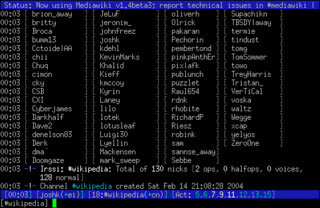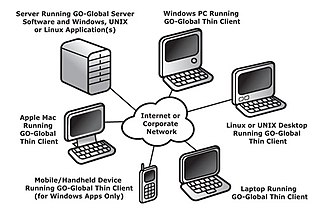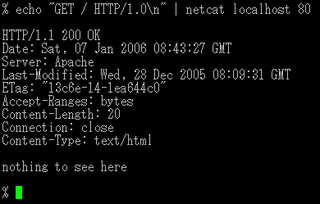Telnet is a protocol used on the Internet or local area network to provide a bidirectional interactive text-oriented communication facility using a virtual terminal connection. User data is interspersed in-band with Telnet control information in an 8-bit byte oriented data connection over the Transmission Control Protocol (TCP).
Network File System (NFS) is a distributed file system protocol originally developed by Sun Microsystems in 1984, allowing a user on a client computer to access files over a computer network much like local storage is accessed. NFS, like many other protocols, builds on the Open Network Computing Remote Procedure Call system. The NFS is an open standard defined in Request for Comments (RFC), allowing anyone to implement the protocol.
The File Transfer Protocol (FTP) is a standard network protocol used for the transfer of computer files between a client and server on a computer network.
stunnel is an open-source multi-platform application used to provide a universal TLS/SSL tunneling service.
In computing, the Windows Sockets API (WSA), later shortened to Winsock, is a technical specification that defines how Windows network software should access network services, especially TCP/IP. It defines a standard interface between a Windows TCP/IP client application and the underlying TCP/IP protocol stack. The nomenclature is based on the Berkeley sockets API model used in BSD for communications between programs.
Independent Computing Architecture (ICA) is a proprietary protocol for an application server system, designed by Citrix Systems. The protocol lays down a specification for passing data between server and clients, but is not bound to any one platform. Citrix's ICA is an alternative to Microsoft's Remote Desktop Protocol (RDP).

In computing, Virtual Network Computing (VNC) is a graphical desktop-sharing system that uses the Remote Frame Buffer protocol (RFB) to remotely control another computer. It transmits the keyboard and mouse events from one computer to another, relaying the graphical-screen updates back in the other direction, over a network.
IPX/SPX stands for Internetwork Packet Exchange/Sequenced Packet Exchange. IPX and SPX are networking protocols used primarily on networks using the Novell NetWare operating systems.

UnixWare is a Unix operating system. It was originally released by Univel, a jointly owned venture of AT&T's Unix System Laboratories (USL) and Novell. It was then taken over by Novell. Via Santa Cruz Operation (SCO) it went on to Caldera Systems, Caldera International, and The SCO Group before it was sold to UnXis. UnixWare is typically deployed as a server rather than a desktop. Binary distributions of UnixWare are available for x86 architecture computers. UnixWare is primarily marketed as server operating system.

A shell account is a user account on a remote server, traditionally running under the Unix operating system, which gives access to a shell via a command-line interface protocol such as telnet or SSH.
The Berkeley r-commands are a suite of computer programs designed to enable users of one Unix system to log in or issue commands to another Unix computer via TCP/IP computer network. The r-commands were developed in 1982 by the Computer Systems Research Group at the University of California, Berkeley, based on an early implementation of TCP/IP.
In computer networking, port forwarding or port mapping is an application of network address translation (NAT) that redirects a communication request from one address and port number combination to another while the packets are traversing a network gateway, such as a router or firewall. This technique is most commonly used to make services on a host residing on a protected or masqueraded (internal) network available to hosts on the opposite side of the gateway, by remapping the destination IP address and port number of the communication to an internal host.
In computer networks, a tunneling protocol is a communications protocol that allows for the movement of data from one network to another. It involves allowing private network communications to be sent across a public network through a process called encapsulation.
The Line Printer Daemon protocol/Line Printer Remote protocol is a network printing protocol for submitting print jobs to a remote printer. The original implementation of LPD was in the Berkeley printing system in the BSD UNIX operating system; the LPRng project also supports that protocol. The Common Unix Printing System, which is more common on modern Linux distributions and also found on Mac OS X, supports LPD as well as the Internet Printing Protocol (IPP). Commercial solutions are available that also use Berkeley printing protocol components, where more robust functionality and performance is necessary than is available from LPR/LPD alone. The LPD Protocol Specification is documented in RFC 1179.
A network socket is an internal endpoint for sending or receiving data within a node on a computer network. Concretely, it is a representation of this endpoint in networking software, such as an entry in a table, and is a form of system resource.
A Unix domain socket or IPC socket is a data communications endpoint for exchanging data between processes executing on the same host operating system. Valid socket types in the UNIX domain are: SOCK_STREAM, for a stream-oriented socket; SOCK_DGRAM, for a datagram-oriented socket that preserves message boundaries ; and SOCK_SEQPACKET, for a sequenced-packet socket that is connection-oriented, preserves message boundaries, and delivers messages in the order that they were sent. The Unix domain socket facility is a standard component of POSIX operating systems.

A super-server or sometimes called a service dispatcher is a type of daemon run generally on Unix-like systems.

GraphOn GO-Global is remote access/application publishing software that allows users to access and run Windows, Linux, and UNIX applications installed on a central server. GO-Global displays the application's user interface on personal computers and other client devices running a variety of operating systems, including UNIX, Linux, Mac OS X, Windows, Windows Mobile, and Pocket PC. GO-Global can be used to Web-enable existing applications without the need to modify existing code. Applications appear on the client device either in a Web browser or within a loose window on the desktop.
FastCGI is a binary protocol for interfacing interactive programs with a web server. It is a variation on the earlier Common Gateway Interface (CGI). FastCGI's main aim is to reduce the overhead related to interfacing between web server and CGI programs, allowing a server to handle more web page requests per unit of time.






